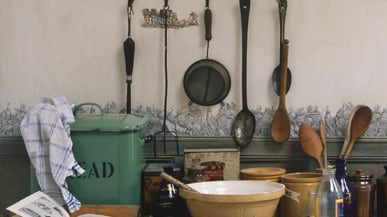Avant-garde cooking is having a very good year. The cooking style was recently canonized in Nathan Myhrvold’s lavishly photographed, six-volume tome Modernist Cuisine: The Art and Science of Cooking. High priests of haute cooking, Ferran Adrià and Wylie Dufresne, best known for bringing laboratory techniques to the plate, traded in their whites for tweed and stepped into the classroom at Harvard. And on the Syfy channel, Top Chef alum Marcel Vigneron puts molecular gastronomy on display in Marcel’s Quantum Kitchen.
But there’s another movement afoot in lay cooking circles, one that’s looking backward rather than forward. Home cooks are finding inspiration in the past, digging up centuries-old recipes more familiar to the likes of Thomas Jefferson than Thomas Keller.

About a year ago Shannon Mustipher, 32, a food activist who lives in Brooklyn, started testing recipes from 18th- and 19th-century American cookbooks. Intrigued by the roots of African-American cuisine in her hometown of Charleston, South Carolina, Mustipher began researching the food of James Hemings, Thomas Jefferson’s chef, and other early African-American cooks. She planned a Thanksgiving dinner that took several cues from early American Thanksgivings, buying nothing from commercial grocers. In fact, she avoided them altogether for six months.
“I tried to think what would happen if I was living in 1675 and imagined myself in that role,” she said.
Mustipher said she likes the bygone eras evoked in old recipes and cookbooks: “I am struck by what reads to me like essays on morals and ethics. They talk about being a good person and keeping a household.”
Her approach to finding recipes, however, is typically modern: Mustipher searches for public domain cookbooks on the Internet and downloads them to her Kindle. Among her favorites is Amelia Simmons’ American Cookery, the first cookbook by an American published in 1796.
Laura Kenyon, a 33-year-old blogger, lives in Canandaigua, New York and cooks recipes of a slightly later vintage, mostly from the 1940s to 1970s. She started the blog Retro Recipe Challenge in 2006 and invites other bloggers to cook recipes written before 1980. Like Mustipher, Kenyon sees preparing vintage recipes as a way of exploring history. She rummages for old cookbooks at vintage stores, flea markets, and church lawn sales.
“They’re a snapshot of what our country or any country was like at that time,” she said. Bonnie Slotnick, the owner and operator of an antiquarian and out-of-print cookbook store in New York’s West Village, said she’s noticed an increase in people looking for centuries-old cookbooks.
“It’s not enough that I can pay my rent this month,” she said, “but there’s definitely an increased interest.”
There is one book she can’t keep in stock, and it’s not Myhrvold’s opus.
“The 1969 Betty Crocker cookbook is the most popular, the most in-demand cookbook in the United States right now,” Slotnick said.
Even with the convenience of modern appliances, cooking like Amelia Simmons, the original American cookbook author, is no easy feat today. Relying on outdated texts can pose a challenge. Recipes often call for obscure animal parts (written at a time when people raised and slaughtered their own animals) and lack particulars about cooking times and temperatures. Just like with today’s haute cooking, when an old recipe fails, it can bomb. Take Marsala Gelee—retro gelatin shots—which Kenyon recently attempted.
“It was disgusting,” she said.
Yet many grab hold of grandma’s recipes because they are often easier to pull off. “Even if you’re really into food, being able to cook something retro is more accessible than cooking that spring pea foam. If I want to play in my own kitchen, I need to play with something that I can find,” Kenyon said.
Plus even the most intrepid home cook likely doesn’t have access to the tools of modernist cuisine like agar-agar (Japanese gelatin), or transglutaminase (aka “meat glue”), so testing a long-lost recipe allows experimentation, even without liquid nitrogen or a syringe at hand.
Classics like meatloaf, fondue, and chicken potpie still find a home on many American menus, but leading chefs seem prepared to get into the act too. In the fine dining world, Chicago’s Grant Achatz, a wizard of molecular gastronomy, opened Next restaurant, which features a rotating menu that focuses on a specific time and place every three months. Achatz’s current theme? Paris 1906—Escoffier at the Ritz.
Plus: Check out Hungry Beast, for more news on the latest restaurants, hot chefs, and tasty recipes.
Claire Saffitz is a writer living in New York.






